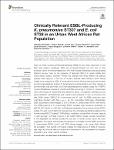Clinically Relevant ESBL-Producing K. pneumoniae ST307 and E. coli ST38 in an Urban West African Rat Population
Schaufler, Katharina
Nowak, Kathrin
Düx, Ariane
Semmler, Torsten
Villa, Laura
Kourouma, Laye
Bangoura, Karim
Wieler, Lothar H.
Leendertz, Fabian H.
Guenther, Sebastian
High-risk ESBL-producing Enterobacteriaceae (ESBL-E) have been described in wild birds and rodents worldwide. Rats are of special interest not only due to their indicator role for environmental pollution with multi-resistant bacteria but also as possible infection source. Data on the presence of high-risk ESBL-E in urban wildlife from Africa remain scarce, however. Twenty-nine animals from three different rat (Rattus) species were captured in the city of Conakry (Guinea, West Africa) in 2015. Rectal swabs were analyzed for ESBL-E using selective media. Species typing and phenotypic antimicrobial resistance analysis to broad-spectrum beta-lactams and other classes of antimicrobials was performed for Enterobacteriaceae-like isolates using the VITEK®2 system (BioMérieux, Germany). Confirmed ESBL-producing E. coli and K. pneumoniae were whole-genome sequenced and resistance genes, phylogenetic background and genes related to bacterial fitness and virulence were analyzed. In total, six of twenty-nine rats (20%) carried ESBL-E (K. pneumoniae and E. coli). All ESBL-producers were multi-drug resistant with blaCTX−M−15 as the dominating ESBL-type. Interestingly, ESBL-associated clonal lineages E. coli ST38 and K. pneumoniae ST307 were found. The ESBL-plasmid in K. pneumoniae ST307 revealed high sequence similarities to pKPN3-307_TypeC, a >200 kbp IncFII plasmid originating from a human clinical ST307 isolate. This was in contrast to the core genome: the rat isolate was distantly related to the human clinical ST307 isolate (27 SNPs/Mbp). In addition, we identified π-fimbrial, capsule 2, and glycogen synthesis clusters in the rodent ST307 isolate, whose involvement in the adaptation to survival outside the host and in human urinary tracts has been suggested. Our results demonstrate the presence of clinically relevant, ESBL-producing K. pneumoniae ST307 and E. coli ST38 clonal lineages in an urban West African rat population. The human community is likely the initial source of ESBL-E however, rats might function as infection source and transmission hub, accelerated by frequent interactions at a human-wildlife interface.
Dateien zu dieser Publikation
Keine Lizenzangabe

